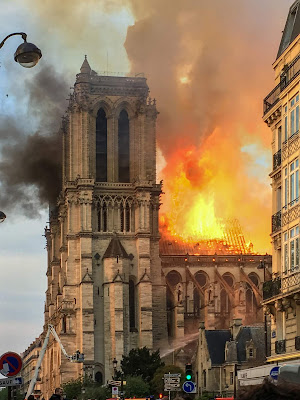The medieval churchgoer was laughing at devils and spirits that he knew were vanquished. Today we chuckle nervously at devils we’re not quite sure aren’t real.
 |
|
A comic demon gargoyle at Visby Cathedral, Sweden. Courtesy Alexandru Baboş Albabos
|
After last week’s post on Notre-Dame, a reader asked, “I just learned that gargoyles are functional art. Any idea why they tend to be hideous?”
The word gargoylecomes from Medieval Latin and Old French, and means ‘throat’ or ‘gullet.’ It’s certainly more poetic than ‘downspout,’ which is what a gargoyle actually is. In English, gargoyle has come to be used for what are more properly known as chimeras or grotesques. These are the fantastic or mythical figures used for decoration in architecture.
Gargoyles are usually elongated to divert water from the wall. That’s why they’re the most visible of all the grotesques. We think of them as medieval, but water deflection has been a part of architecture forever, as has whimsy. The Egyptians and Greeks both used lions’ heads as gargoyles.
 |
|
Waterspouts and other sculptured figures on the Freiburger Münster, Germany. The top waterspout is defecating. Courtesy Rebecca Kennison
|
But it was with medieval Catholic architecture that the gargoyle reached its highest art form. Sculptors of the Gothic cathedrals were expected to be ‘preachers in stone’ to the mostly-illiterate population of the time. They told the stories of the Bible, but also portrayed the animals and beings of popular imagination. Since their society was earthy, these figures can sometimes be doing things we think aren’t appropriate for church, like defecating.
Grotesques were not universally popular. Abbot Bernard of Clairvauxrailed against them in his monastery:
“What are these fantastic monsters doing in the cloisters before the eyes of the brothers as they read? What is the meaning of these unclean monkeys, these strange savage lions, and monsters? To what purpose are here placed these creatures, half beast, half man, or these spotted tigers? I see several bodies with one head and several heads with one body. Here is a quadruped with a serpent’s head, there a fish with a quadruped’s head, then again an animal half horse, half goat… Surely if we do not blush for such absurdities, we should at least regret what we have spent on them.”
 |
|
Le Stryge is a 19thcentury Gothic Revival strix on the North Tower at Notre-Dame and reflects Victorian sensibilities. Courtesy Prosthetic Head
|
One of the most famous grotesques at Notre-Dame is not medieval at all, but Victorian. Le Stryge is a brooding demon who (until last week, at least) perched atop a buttress on the north tower. Nineteenth century Paris was obsessed with occultism; the grotesques added to Notre-Dame during its renovation reflect that.
Medieval society was less preoccupied with sin. “Whatever they may have lacked, the Middle Ages were a time when fun was ‘fast and furious,’ certainly in no respect behind our own day,” wrote architect Ralph Adams Cram in 1930. “Just because they were sincerely religious people and involved in the sacraments… of their religion from the day of birth to that of death—and after—it is assumed they… must have been sad, terror-stricken and morose.”
 |
| This dear little reading monkey grotesque is Bavarian. Courtesy )o(Medousa)o(. |
It’s been theorized that the grotesques of medieval architecture were to ward off sin or were pagan representations slipped into Christian art. That theory would have seemed absurd to the churchmen who oversaw construction of these churches. They were, in general, far more sophisticated theologians than we are today.
What they had that we don’t, is an ability to laugh at cosmic jokes. The greatest of these is the death and subsequent resurrection of Jesus Christ, which puts Satan firmly in thrall. The medieval churchgoer was laughing at devils and spirits that he knew were vanquished. Today we chuckle nervously at devils we’re not quite sure are real.




